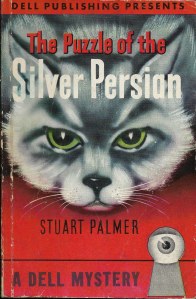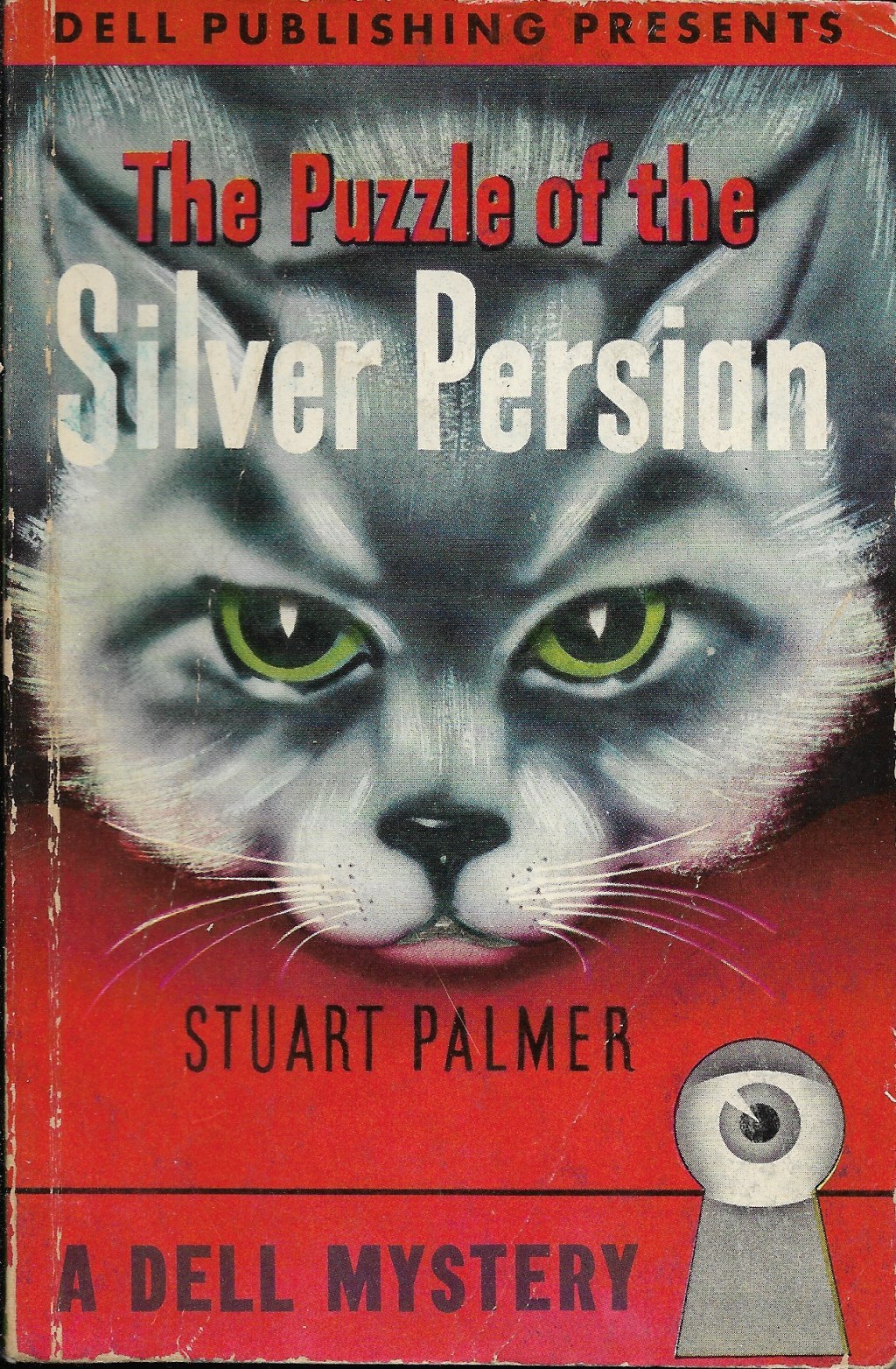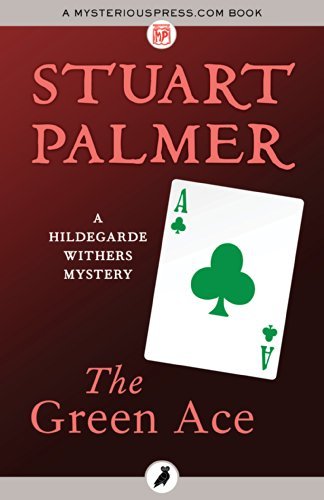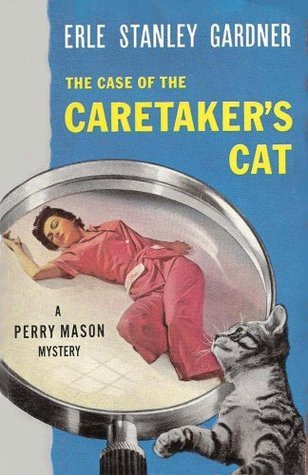The Puzzle of the Silver Persian by Stuart Palmer is my sixth book that I’ve read for #ReadingtheMeow2024 hosted by Literary Potpourri. The Puzzle of the Silver Persian is my third foray into the Miss Withers series and it was kind of a disappointment, both as a mystery and as a cat mystery, but we’ll get into that later.

Plot Summary
The Puzzle of the Silver Persian begins aboard the cross-Atlantic cruise ship The American Diplomat, where the silver Persian cat of the title, a rambunctious cat named Tobermory, tries to shimmy his way through the porthole of his owner, the Honorable Emily Pandavid, luxurious cabin. He is, however, sprayed with salty surf, decides to save all of his nine lives for another day, and begrudgingly stays on board.
Emily Pendavid is joined on her crossing of the Atlantic by her passive but agreeable nephew Leslie Reverson, the very seasick Miss Withers, the jolly and outgoing Dr. Waite, a bright young thing of nineteen named Rosemary Fraser, Rosemary’s chaperone and friend, Candida Noring, the lively prankster, Andy Todd, whose crossing to complete his schooling in England, and the Hammond family, Mr. Hammond, a man with a wondering eye, Loulu Hammond, his unhappy wife, and their devil incarnate child, Gerald.
The tension between the cast of characters begins almost immediately when Andy Todd, an overly concerned young man, offers to buy a round of drinks for the Hammonds, Rosemary, and Candida. Rosemary immediately rebuffs him, but the Hammonds accept—Mrs. Hammond to watch her husband and Mr. Hammond to ogle Rosemary. After the rest of the party leaves, Andy Todd heavily drinks and talks to the barman.
That same night, the characters, minus the ailing Miss Withers, who share the same table for dinner, are regaled by tales of the sea, by ship’s doctor, Dr. Waite. Again, Andy Todd makes his interest in Rosemary known, but she deftly refuses his advances and, after dinner, when the dancing begins, makes clear that he’s not on her dance card.
Hot under the collar, Andy Todd pays the loathsome Gerald, who has been destroying the ship’s piano, a dollar to catch Rosemary in flagrante with another passenger. When Gerald reports to Andy Todd that he’s found Rosemary necking, Todd leads his fellow tablemates to the affair scene. Still, Rosemary and her paramour are nowhere to be seen- however, a tell-tale scrap of squirrel coat- a signature of Rosemary is found left behind.
For the next few days, Rosemary broods over the little scandal, and Andy Todd eggs on continual gossip and heavily hints Mr. Hammond was Rosemary’s partner, to Mrs. Hammond’s displeasure and Mr. Hammond’s staunch refusal- saying he was playing craps with the doctor during this whole affair. Finally, at the urging of Candida, Rosemary rejoins her tablemates, and when they open the little party favors on the table- Rosemary’s jappaned box holds the key to the room where her affair took place. Embarrassed, she and the rest of the table laugh, minus the bewildered Miss Withers, before she hastily leaves.
That same night, Rosemary stands beside the rail of the ship within eyesight of Miss Withers, who is dozing lazily. One minute, she’s there; the next, she’s gone. A while later, Candida comes by asking Miss Withers if she has seen Rosemary; she is afraid that the girl has committed suicide because of the scandal. Candida and Miss Withers make a cursory search of the ship and then notify the captain. He records her death, and the next day, British authorities arrive on board the docked American Diplomat to interview the passengers. Candida tells the police that the bartender was the man with whom Rosemary had her fling, and in a panic, he eats a damning piece of evidence- a piece of paper, it’s coated in cyanide, and he dies instantly.
It’s a tragic scene, and the passengers disembark in England thinking that once the inquest happens, they will leave the unpleasantness of the voyage behind them. However, within a few days of arrival, the passengers who sat with Rosemary started receiving poisoned pen letters. Andy Todd is found dead at the bottom of an elevator shaft, and Candida Noring is sent poisoned cigarettes.
Miss Withers wonders if this is a case of planned mass killings out to revenge Rosemary. Who is behind the killings, and when will they stop? Miss Withers follows the killer’s trail to Miss Emily Pendavid’s ancient and beautiful castle on the remote cliffs of England before she discovers the vital clue, all thanks to the silver Persian, Tobermory.

The Review
The Puzzle of the Silver Persian takes place immediately after The Puzzle of the Pepper Tree, Miss Wither’s preceding case, and I didn’t know that going into the story. Unfortunately, the ending to the previous story is spoiled, and the emotional ramifications of the previous case are so great that Miss Withers is taking a leave of absence from her teaching job to go on this restful cruise to England. This setup means two things: I highly recommend reading The Puzzle of the Pepper Tree before beginning this book, and Miss Withers is not like herself for most of the book. In a state of near mental collapse, beset by seasickness, adrift on the open ocean, and then attempting to solve this murder case without the resources of Oscar Piper, the New York Metropolitan Police force, or even the American legal system- Miss Withers is adrift.
There’s a real sense of melancholy pervading this book; Miss Withers is often either miserable, unsure of what is happening around her (she was absent for all of the action surrounding Rosemary), and then once she gets her footing on dry land, literally and figuratively, she forces an uneasy alliance with Scotland Yard. All of this makes for rather unpleasant reading. The fish out of water element goes on for too long, and I didn’t enjoy watching Miss Withers struggle and scabble to get hold of an entry point in her own story. I think the mystery would have been better served having Miss Withers make observations of her fellow passengers, watching their petty squabbles and malicious interactions, and holding her own in the fray. She’s at a distinct disadvantage from the start.
I enjoyed the Scotland Yard police officers trying to solve the three separate incidents and how Miss Withers took the youngest and most inexperienced officer under her wing. It was a mutually advantageous relationship different from the hardboiled and world-weary Oscar Piper with whom she usually duos. Still, again, the relationship is forged too late into the book. She is never in the confidence of Scotland Yard, who solves the crimes independently, but allows her to monologue how she also solved the crimes at the end of the book, which is them but also a bit silly.
The whole case is silly; the motive for revenge is revealed too early, and only one person has the motive to plot wholesale revenge against the people who wronged Rosemary. There’s sort of half-baked red herrings, and Palmer does try to build a smoke screen with the possibility that Rosemary is still alive but undercuts that by having Rosemary wash up on the shore of the Thames. He then undercuts any potential ambiguity of when Rosemary died by stating for a fact that she’d been dead 15 days by the time she washed ashore. I think this is supposed to create confusion, but there’s only one way a body that’s gone overboard can then resurface in the same place as the docked boat. I bet you’ll be able to figure it out if you think about it for a minute.
There’s just too much evidence and an unparalleled strong motive to make this much of a mystery, and again, even Miss Withers tells the police at the end that she’s known who the killer has been for a while but hasn’t reported them because she feels the killings were justified and has a terrible guilt complex about sending the killers to the gallows in the previous story. Now, Miss Withers’s complex relationship to capital punishment is explored in The Green Ace when she investigates a man on death row claiming innocence, so there is a good story that comes out of this moral dilemma, but even with Miss Withers repugnance about capital punishment, I have a tricky tie squaring the idea that she would let a murderer go free, In the end, she only agrees to hand over the murderer when they kill the innocent Emily Pendavid in cold blood. I think this is supposed to drive home to Miss Withers that there’s no such thing as a reformed murderer; it’s a hard lesson to watch her learn, and I am not sure it’s one she needs.
Miss Withers, more unsteady and bumbling than in other stories, is uncomfortable to read about but is head and shoulders above reading about the pompous Andy Todd or watching the disintegration of the Hammond’s marriage due to a malicious lie by their beastly progeny, Gerald. And, we get a good helping of how horrible Gerald is because there’s a strange subplot where Emily Pendavid has to deliver him to a boy’s school in England. After all, his mother is running errands in Paris.
Emily Pendavid, a truly generous, funny, and up-for-anything kind of woman, is sorely taken advantage of by Mrs. Hammond in somehow persuading her to take Gerald to this school. The bright spot was more Emily Pendavid and the antics of Tobermory, who has been spending every waking moment trying to eat an American robin, who flew onto the ship before it set sail,l, and Emily Pendavid adopted….to keep it from getting eaten by a cat. Oh, Mrs. Pendavid, as a proud owner of cats, this plan was doomed from the start.
The paper-thin subplot of delivering Gerald to his school is patently dumb. It isn’t even necessary to get Miss Withers to Emily Pendavid’s castle because Emily writes Miss Withers and invites her a few days later. In any case, Miss Withers haunts the old castle, looking for clues and a way to manipulate the murderer when Emily Pendavid is killed. The only clue to when she dies is when Tobermory ate the robin.
Okay, so as Miss Withers explains in the story, Tobermory would have only eaten the robin when he sensed his mistress was dead because otherwise, he would get smacked with a newspaper, which would deter him, and I call bullshit. I have owned seven cats in my lifetime, including two main coons, which are not precisely like Persians, but pretty close and let me tell you- no punishment would ever deter them from eating a pet bird. If they could get to it- they would. I definitely wouldn’t hang evidence for a MURDER on this “fact.” however, this is when Miss Withers realizes the murderer she has been shielding will kill them all if she doesn’t provide the murderer’s written confession to the police, which she’s had in her possession for at least a few hours.
Umm, say what?
A written confession that she took as insurance and because they can’t be used as evidence- however, in Britain, a signed confession damns the signer to the gallows, a devastating and costly mistake for the emotionally fragile Miss Withers. So she has, through her incompetence, sent someone to their death. Again, this lack of research is strange for the always correct, economical, research-minded Miss Withers. She’s a school teacher who prides herself on knowing everything and the consequences of her actions. I think this blunder is made to drive home just how out of her depth Miss Withers is, but it’s a sad note to end the story. We, the readers, want to see her triumph, to beat back her blues, to make her piece with sending murderers to their deaths, and we don’t. It’s a melancholy end to a sad story.
The Puzzle of the Silver Persian breaks the formulaic mold of Miss Wither’s stories with bold narrative choices that didn’t pan out for me. The drastic changes to Miss Wither’s character felt odd, and we’re resolved by the end of the book, making me wonder if they will bleed into the next story. I was also disappointed that for a book titled The Puzzle of the Silver Persian, the cat is used only to bookend the story with a few comedic moments sprinkled in. His damning evidence felt slight and laughable when put up against scrutiny. The Puzzle of the Silver Persian wasn’t a bad book; the characters were well drawn, the mystery passable, with a clever setting and the beginnings of an excellent closed circle mystery, but it floundered. It never used the closed circle or the setting because most of the story takes place in England. It’s a mediocre and meandering mystery that isn’t up to the dizzying caliber that Stuart Palmer is capable of, as shown in his first Miss Wither story, The Penguin Pool Murder.
Miss Withers Book Reviews
Stuart Palmer Biography

Stuart Palmer was an American author best known for his mystery novels featuring the character Hildegarde Withers, a schoolteacher turned amateur detective. Born on March 28, 1905, in Baraboo, Wisconsin, Palmer initially pursued a career in advertising before finding success as a writer.
Palmer’s literary career took off with the publication of his first novel, “The Penguin Pool Murder,” in 1931. This novel introduced readers to Hildegarde Withers, a sharp-witted and no-nonsense schoolteacher with a knack for solving crimes. Withers often finds herself embroiled in murder mysteries, using her intelligence and observational skills to crack cases that baffle the police.
Throughout the 1930s and 1940s, Palmer wrote a series of Hildegarde Withers novels and short stories, earning a reputation as one of the leading authors in the mystery genre. His works were known for their clever plots, engaging characters, and witty dialogue. Some of the most popular titles in the series include “Murder on the Blackboard,” “The Puzzle of the Happy Hooligan,” and “The Green Ace.”
In addition to his Hildegarde Withers mysteries, Palmer also wrote screenplays for Hollywood films, including adaptations of his own novels. He collaborated with filmmakers such as RKO Pictures and Paramount Pictures, bringing his beloved characters to the silver screen.
Palmer’s contributions to the mystery genre were significant, and his works continue to be enjoyed by readers and fans of classic detective fiction. He passed away on February 4, 1968, leaving behind a legacy of memorable characters and timeless mysteries.













Leave a comment